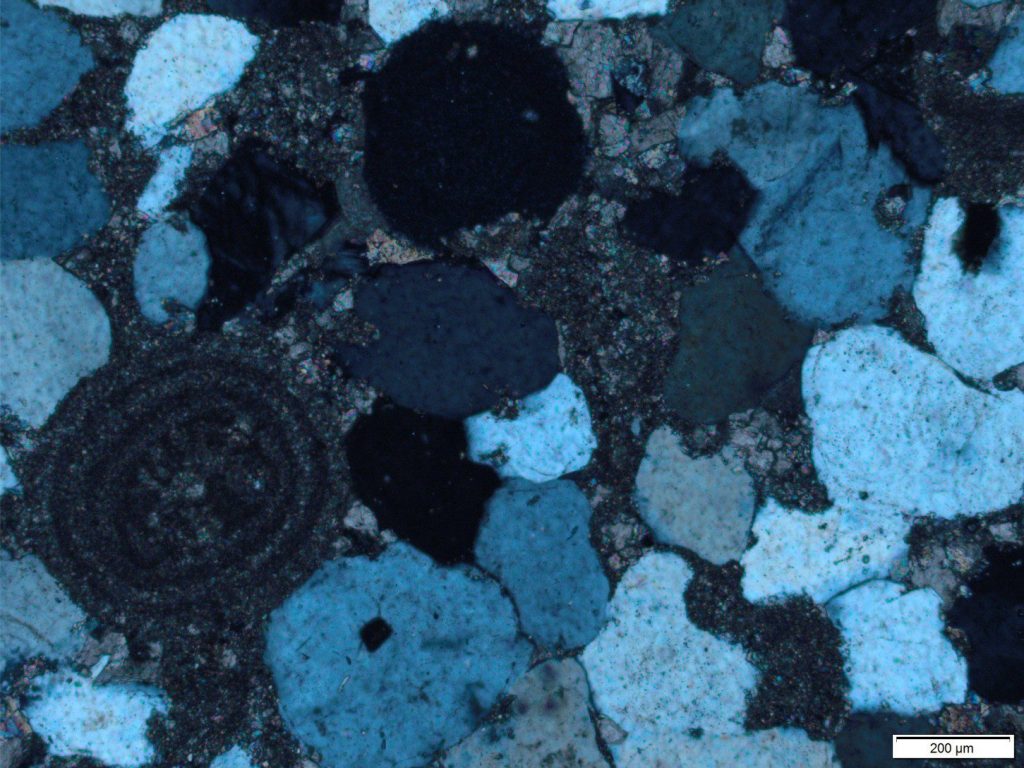
The selection of sandstones in plain polarized light (left) and crossed nicols (right) shown here illustrate common petrographic attributes. Abbreviations are explained in the caption to each set. For explanations of terminology see the relevant articles in this series.
Arenite classification is from Pettijohn, Potter and Siever, (1973).
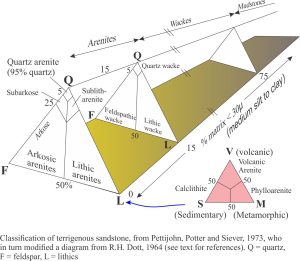
The assessment of rock paragenesis (diagenetic history) is based, where possible, on cement stratigraphy, cross-cutting relationships of cements and replacement textures, recrystallization textures, and any structural fabrics that might be present.
Refer to this link for a reminder of optical mineralogy terminology
Common textural descriptions in thin section
The two images below are annotated to show the common textural properties of sandstones. The thin section is shown only in plain polarized light; in most cases it is easier to see textural attributes in PPL than under crossed nicols. A scanning electron micrograph (SEM) of a rock from the same formation reminds us that all physical aspects of a rock are three dimensional.
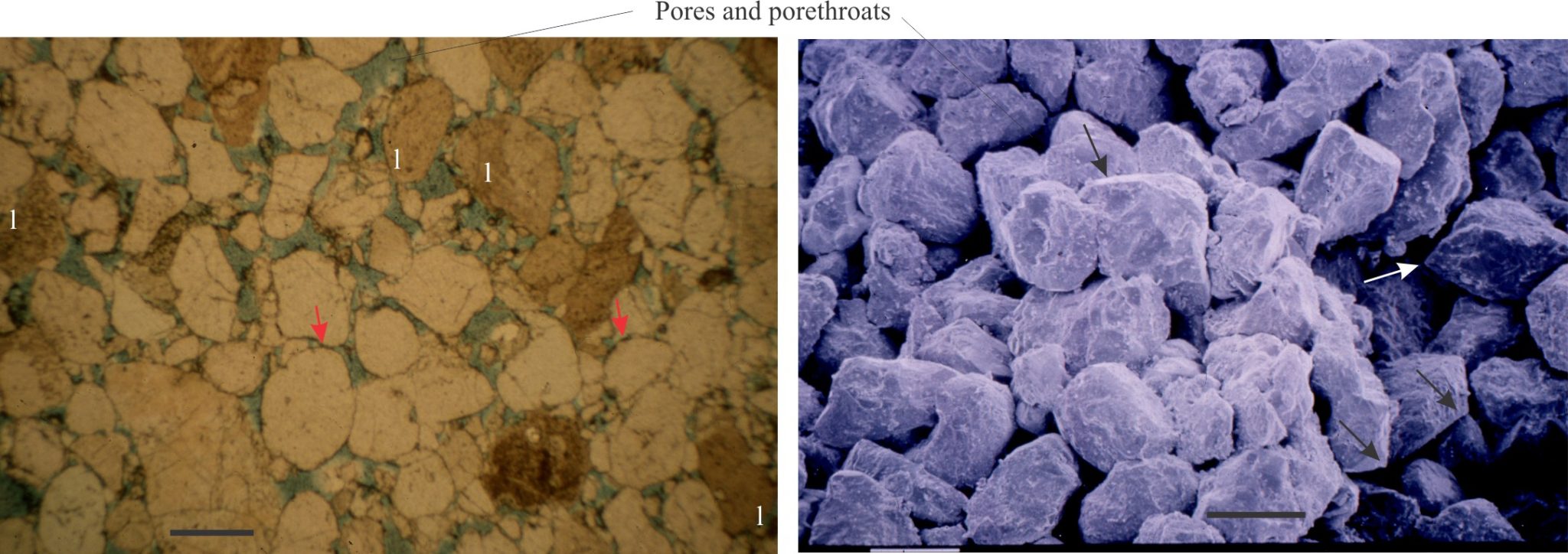
- Grain size. Medium sand.
- Sorting. Well to moderately well-sorted – most grains are a similar size and shape.
- Roundness. Well-rounded to subrounded. Care needs to be taken to distinguish original grain boundaries. The SEM image shows several grains with sharp terminations and straight edges that in this example are the result of quartz overgrowths (arrows); i.e., they are diagenetic textures (part of the cementation history) rather than depositional textures.
- Framework. In thin section grains are consistently in 2-D contact, and in the SEM we see 3-D contacts. This is an example of a grain-supported framework.
- Matrix. Intergranular pores contain small amounts of silt-sized quartz-feldspar and clays. Distinguishing detrital clays (matrix) from diagenetic clays is difficult in thin section. However, an SEM of the same rock (below) shows kaolinite ‘books’ and filamentous illite crystals that overlie the quartz overgrowths – these are diagenetic products.
- Porosity. In thin section about 15% (the blue material is resin); 15-20% in the SEM.
- Mineralogy. Quartz 80-90% (clear, irregular fractures but no cleavage), lithics (l) 10-15% – dirty brown colours in PPL, feldspar <5% (good cleavage in PPL). Each component can be described in terms of its composition (mono- or polycrystalline quartz, volcanic or sedimentary lithics, plagioclase or potassium feldspars) – see other posts in this series for details on how to do this.
- Cements. Quartz overgrowths are the first major cement component. In thin section detrital clays are seen as a thin dark rind on grain boundaries (red arrows). In the SEM, clay dustings and tendrils cover all grains (detailed analysis of similar samples shows illite and kaolinite). There are no calcite or dolomite cements in these examples although they are common in many sandstones.
- Rock name. In accord with the classification scheme above: = sublitharenite.
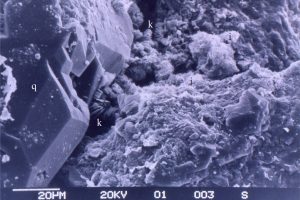
Quartz arenite:
Mukpollo Fm. Paleoproterozoic. Belcher I.
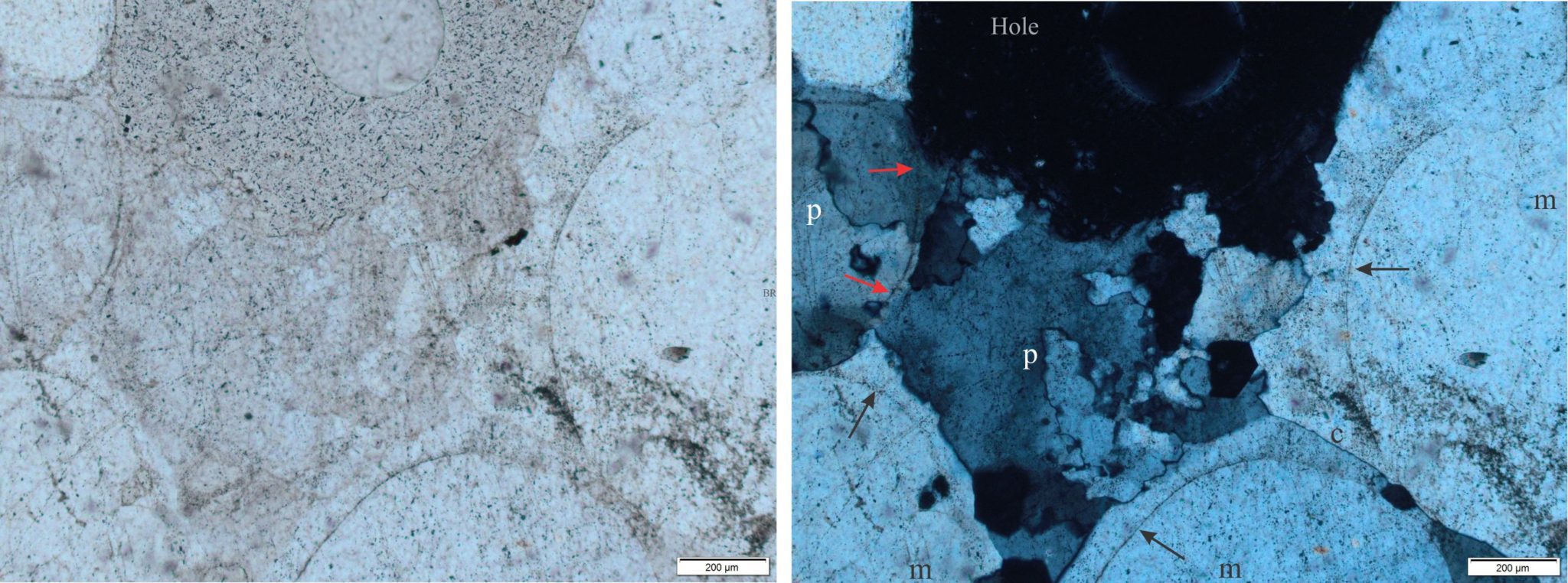
- Coarse-grained, well-sorted, grains well rounded. Clast-supported framework. Original matrix was <10%. The rock is texturally and mineralogically supermature.
- Well-rounded monocrystalline quartz grains (m); original grain boundaries (black arrows) overgrown by syntaxial quartz cement (the cements move into extinction with the parent grain – they are optically continuous).
- There are two polycrystalline quartz grains in this view (p). They too have syntaxial overgrowths that are in optical continuity with each subcrystal (red arrows).
- Polycrystalline grain shapes tend to be less well rounded because they are liable to break along sub-grain boundaries or deform during compaction.
- Contacts between cements in the monocrystalline varieties are usually straight-flat crystal faces (c). Contacts between polycrystalline overgrowths are irregular and interpenetrating.
- Effective porosity is almost zero in this rock. Fluid flow along grain and cement overgrowth boundaries would have been mostly diffusive.
- Provenance: Archean felsic basement rocks. Most of the original feldspar was removed by mechanical abrasion during transport and sediment reworking.
- Paragenesis: A relatively simple progression from deposition → compaction (continuous) → quartz cement precipitation during advective fluid flow.
Quartz arenite:
Mukpollo Fm. Paleoproterozoic. Belcher I.
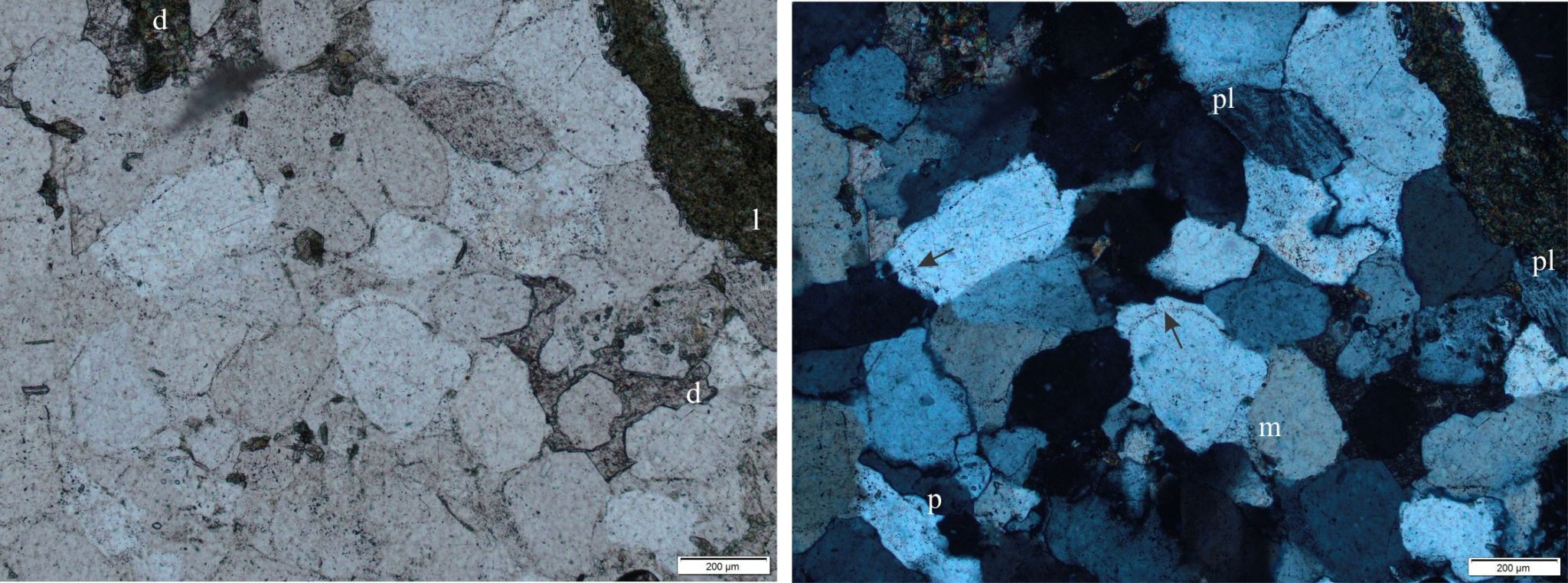
- Well-sorted, grains well rounded. Clast-supported framework. Original matrix was <10%. The rock is texturally and mineralogically supermature.
- As above, dominated by monocrystalline quartz (m – 80%), plus 15% polycrystalline quartz (p), and about 5% feldspar (pl). The lithic clast (l) has been deformed by compaction.
- Quartz overgrowth cements are syntaxial (arrows).
- Plagioclase is partly altered to sericite (a common white mica alteration product) and some chlorite. Some albite twinning is still visible. The alteration products tend to concentrate along cleavage – this makes the distinction between quartz and feldspar a little easier.
- There are two patches of dolomite pore-filling cement (d) that overgrow the quartz cements, and on close inspection show incipient replacement of quartz. Thus, the dolomite is a late diagenetic component.
- Provenance: Archean felsic basement rocks. Most of the original feldspar was removed by mechanical abrasion during transport and sediment reworking.
- Paragenesis: Deposition → compaction (continuous) → quartz cement precipitation during advective fluid flow → a change to carbonate-dominated fluids and precipitation of late dolomite cement at deep burial.
Quartz arenite (polycrystalline quartz)
Taratu Fm. Otago, NZ. Bar scale 1 mm.
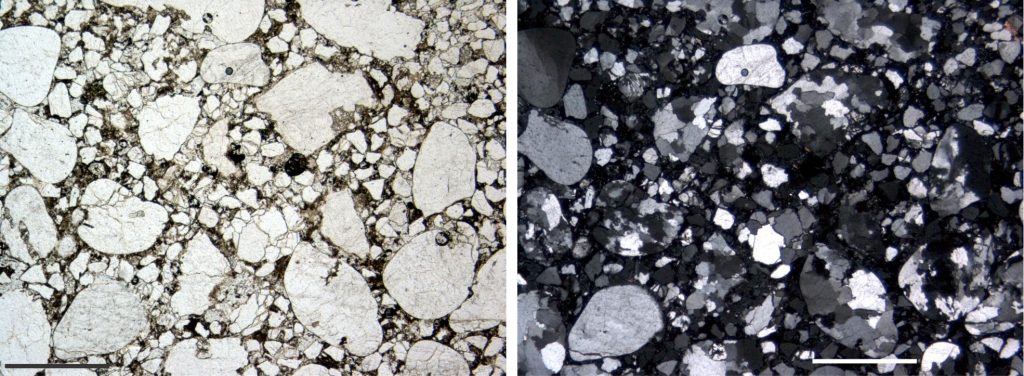
- This sandstone, although >90% quartz, is made up almost entirely of polycrystalline grains where the subcrystals in each grain are equant.
- Grains are well rounded, but several show evidence of breakage along subcrystal boundaries.
- Arenite is texturally submature and mineralogically mature.
- Grain size is bimodal – medium sand size (about 50%) and very fine sand – silt sized grains. Many sand grains appear to ‘float’ in the fine fraction.
- The finer size fraction is much the same size as the whole grain subcrystals.
- We can infer that the fine fraction was derived by breakage of the sand-sized polycrystalline grains.
- There are no quartz overgrowth cements. Intergranular cements are probably kaolinite (according to other studies) but distinguishing this in thin section is difficult.
- Compaction has produced incipient fractures along crystallite boundaries in some polycrystalline quartz grains (arrows).
- The polycrystalline quartz was derived from Otago Schists.
- Image credit: S.G. McMillan, GNS, Petlab database sample OU62786.
Subarkose (plain polarized light only. Bar scale 1mm)
Kapuni Gp. (Paleocene-Eocene), Taranaki Basin.
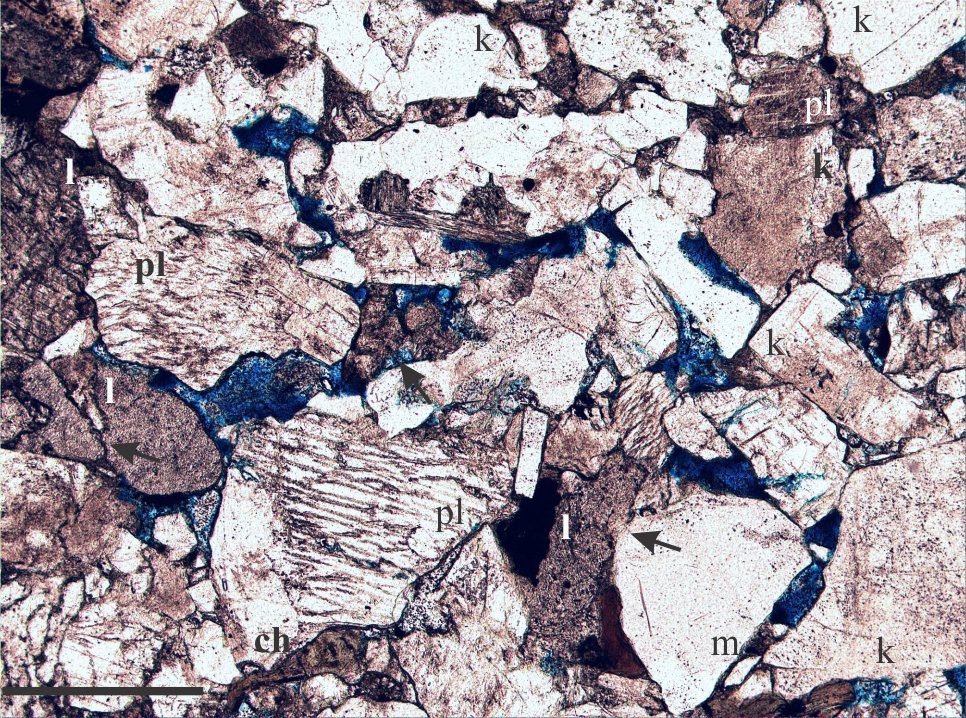
- Poorly sorted, angular to surrounded grains. Fully clast-supported framework.
- Texturally submature, mineralogically immature.
- Feldspar 70%, lithics 15%, monocrystalline quartz 15% (m), the occasional white mica flake.
- Feldspar is a mix of plagioclase (pl) and potassium feldspar (k). Plagioclase can be distinguished by alteration bands that mimic twinning. Alteration tends to be more advanced in the plagioclase grains as a mix of sericite and finely crystalline calcite. The variable degree of alteration among the feldspars suggests that some of it may be inherited from the sediment source.
- In this sample there is little evidence of quartz or feldspar overgrowth.
- Most grains have a thin, dark rim that is probably incipient clay cement. Fibrous chlorite (cl) occurs as the occasional pore filling cement that overlies the dark clay rims.
- In plain polarized light, feldspar can be distinguished from quartz by prevalence of cleavage, and broken, angular grain boundaries that coincide with cleavage planes.
- Lithics are predominantly mudstone-siltstone. Compaction deformation of lithics is visible where they have been moulded or fractured around stronger grains (arrows).
- Blue resin has filled intergranular porosity (About 10-12%).
- Provenance. Primarily felsic plutonic rocks, (granite, granodiorite). Possibly first cycle where removal of mechanically weak feldspar by reworking and abrasion was limited.
- Paragenesis. Deposition → compaction (continuous) → +/- feldspar alteration and minor dissolution → precipitation of clay cements → +/- chlorite cement
- Image credit: GNS, Petlab database sample P46297.
Glauconitic calcareous subarkose
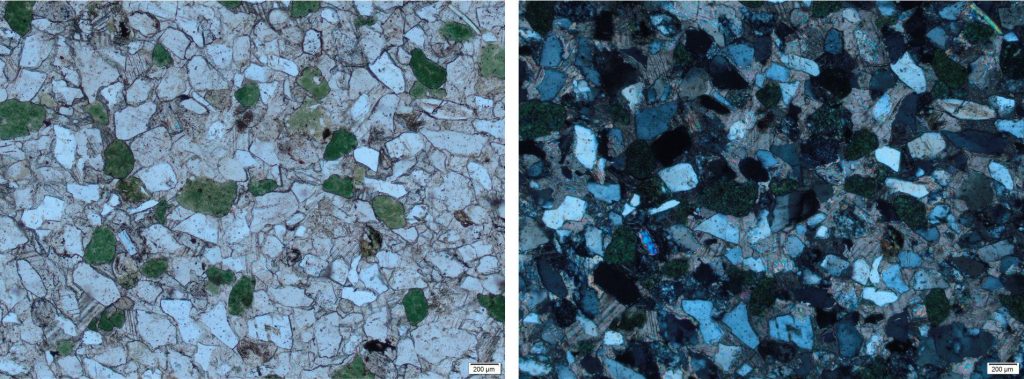
1. Glauconite peloids up to 0.5mm across (10%). Some glauconite grains are deformed around stronger quartz and feldspar grains (by compaction).
2. Quartz grains (70-75%) are mostly monocrystalline (there are a few polycrystalline grains) and show a mix of unstrained and strained extinction. Grains are angular to well rounded, but some of the angularity is due to calcite replacement of quartz (some examples shown by white arrows).
3. Untwinned K-feldspars (5-10%) show varying degrees of sericite alteration. Some appear superficially like lithic grains.
4. Lithics (I) (~5-8%). Be careful to distinguish actual lithics from altered feldspar grains.
5. Cement is coarse calcite spar. Contact between the calcite cement and some framework grains is irregular, indicating replacement of silica by Calcium carbonate.
Lithic arenite (litharenite)
Monster Fm. Upper Cretaceous, Yukon.
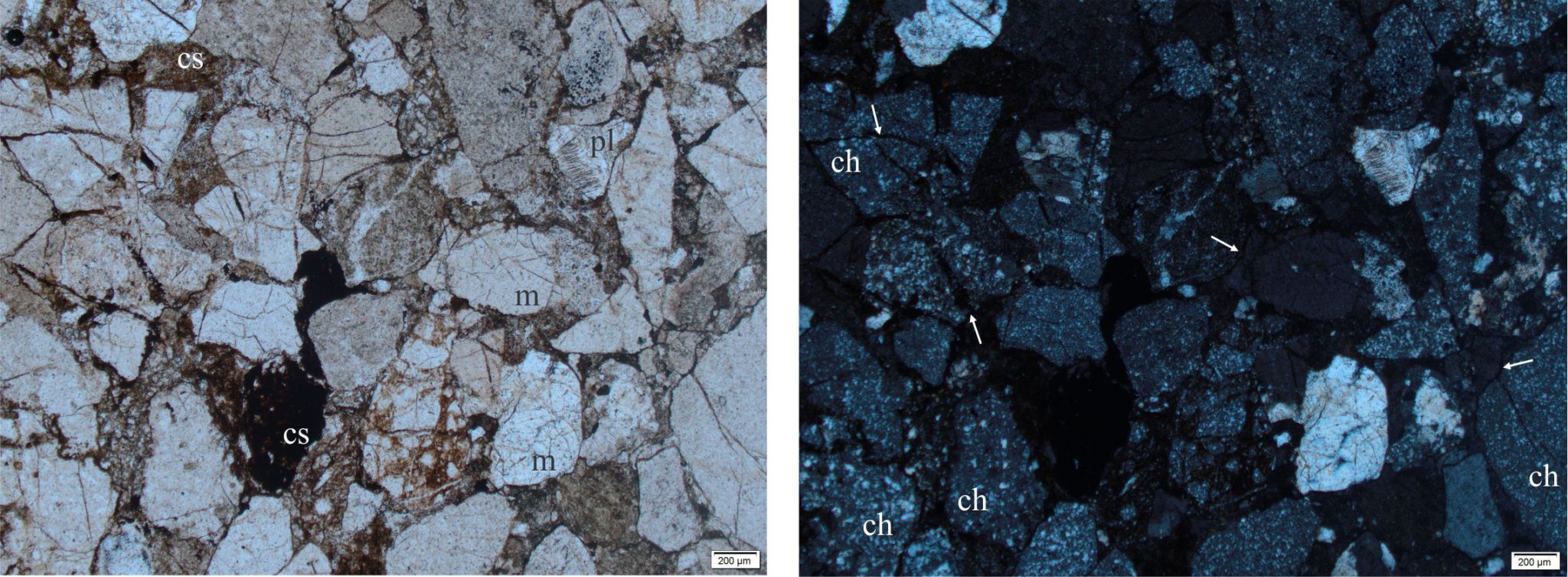
- Moderately well sorted, angular to subrounded grains; clast-supported framework.
- 85-90% lithic grains (ch), <5% monocrystalline quartz (m) and plagioclase (pl), and about 10% matrix.
- In PPL the lighter coloured clasts are mostly chert (ch) and muddy chert. The darker brownish grains are carbonaceous (cs).
- Ductile (indentations and bending) and brittle deformation (fractures) at many grain boundaries caused by compaction (white arrows).
- The distinction between diagenetic clay cement and matrix is difficult. Calcite is rare.
- Provenance. Primarily siliciclastic mudstone, cherty mudstone, carbonaceous or coal-bearing sources. The abundance of lithics, that are mechanically weaker than quartz and feldspar, suggests probably first cycle sediment.
- Paragenesis. Deposition → compaction (continuous) → precipitation of clay cements.
Chert lithic arenite (litharenite)
Cadomin, Lower Cretaceous, Alberta foreland basin.
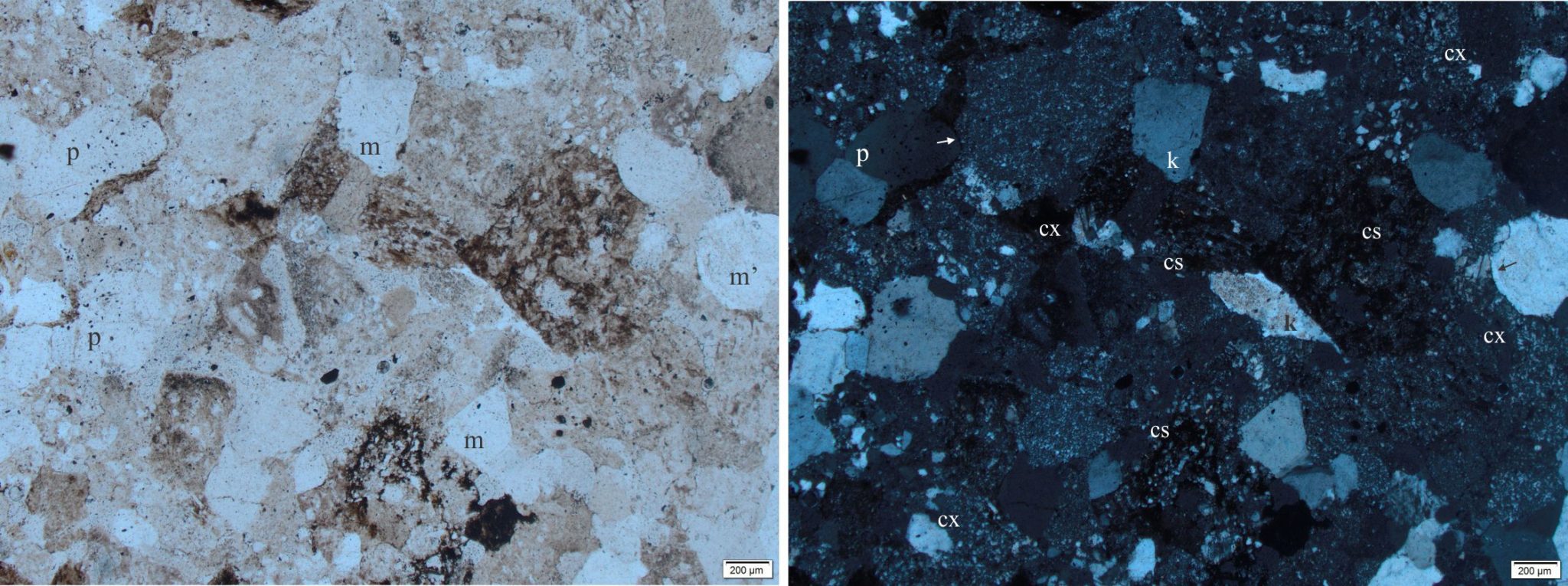
- Moderately well sorted, angular to subrounded, clast-supported framework.
- 65-70% chert and muddy chert (ch), 10-12% carbonaceous siltstone (cs), 10% quartz (m,p), 10-12% matrix, 1-2% feldspar (k).
- Chert grains show varying degrees of recrystallization (cx); some will be inherited from the source rock.
- The monocrystalline quartz grain marked m’ shows a relic grain boundary (arrow), and syntaxial overgrowth that is corroded on its outer edge. This was probably inherited from the source.
- The distinction between diagenetic clay cement and matrix is difficult at this scale of magnification.
- Some ductile deformation at grain-to-grain boundaries caused by compaction – note the indentation of chert by a quartz grain (white arrow, top left).
- Provenance. Recycled sedimentary; may include chert-bearing limestones where the carbonate fraction was winnowed or removed during sediment transport.
- Paragenesis. Deposition → compaction, loss of porosity, some ductile deformation (continuous) → +/- chert recrystallization → precipitation of clay(?) cements.
Sublitharenite
Proterozoic Altyn Fm, southern Alberta
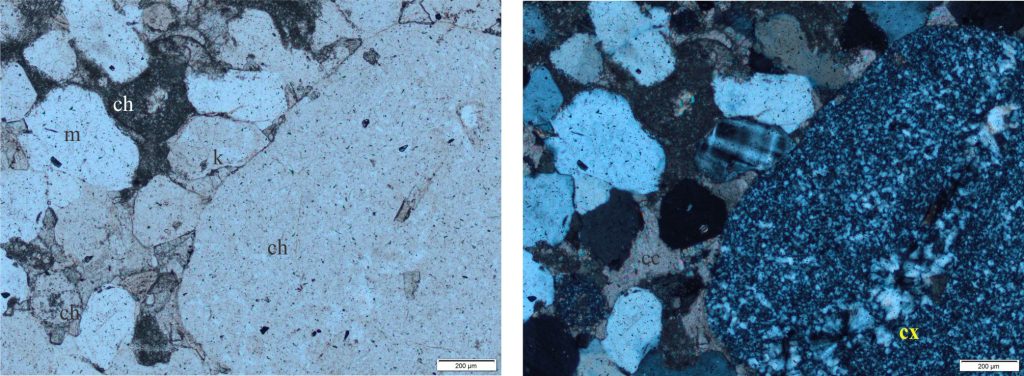
- The main features in this image pair are the chert clasts (ch). The pebble fragment (right) shows varying degrees of recrystallization. There is a noticeable band of recrystallized chert that includes some radial crystal clusters (cx); under crossed nicols these show a characteristic extinction cross that rotates with the microscope stage. The crystal band terminates at the clast margin. There are a few other chert and muddy chert clasts (dirty appearance) that do not show any significant recrystallization. Together, these features suggest that the recrystallization was inherited from the source rock, rather than being a diagenetic product in the sandstone.
- Most quartz grains are monocrystalline (m); the single potassium feldspar has gridiron twinning (k).
- Calcite cement (cc) fills most of the pore space; easily identified because of its high birefringence, high relief, and prominent cleavage. The corrugated contact between the quartz grains and calcite is a result of incipient dissolution and replacement of silica.
- Paragenesis. Deposition → compaction, loss of porosity (continuous) → +/- clay precipitation → precipitation of pore-filling calcite cement and incipient dissolution of silica.
Other posts relevant to this article
The mineralogy of sandstones: porosity and permeability
The mineralogy of sandstones: Quartz grains
The mineralogy of sandstones: Feldspar grains
The mineralogy of sandstones: lithic fragments
The mineralogy of sandstones: matrix and cement
The provenance of detrital zircon
Provenance and plate tectonics

















